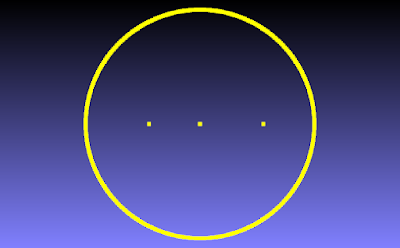I was intrigued when I posted a comment on PBS space times' YouTube video and the response was "do the math".
It took me a while but now at least I have something to point at, and I think it was worth the effort given my lack of background in (astro)physics.
The source code is available in SourceForge for you to try out yourself.
I'm on Debian so you'll need make and g++/clang++, I tried to keep it as simple as possible.
The program generates an ".off" file which describes a point cloud.
The image above is what you get when you load the file into MeshLab and take a snapshot.
This was generated by:
./event-horizon --d=1.6 --res=1e-4You can try other values by varying the parameters, the code isn't that complicated to understand.
Enjoy!
Update 2017-10-03
I wrote a CGAL variant that generates full surfaces but as it turns out one sometimes gets its normals inverted - it looks kinda cool though!
Update 2017-10-03 part 2
With this version one can look around the model and directly modify viewing attributes as well as the distance (d) parameter.
These screenshots were taken from running
./event-horizon-igl -d 1.382012173
The thing to note is the blob hiding in the middle of the combined event horizons - it's outside the event horizon but isolated from the rest of space-time.
It's also shrinking as the singularities approach one another.
I'm guessing its entropy is decreasing too, so time is going backwards.
It may or may not be being bombarded with leaking firewall from the two black holes.
Finally, it's becoming so small and so close to the event horizons that millions or billions of years will pass for it while for us it would be just a moment.
Sounds like a pocket universe to me, a time-reversed big bang!
Update 2017-10-13
It looks like the singularities meet inside that pocket of regular space-time!
I used the radii corrosponding to the 29 and 36 solar mass black holes whose gravity waves were detected.
If you run
./event-horizon --r1=.855484 --r2=1.06198 -d 5e-13 --res=1e-11here's a very zoomed-in view of what you get (the dot in the middle is the origin)
I wasn't expecting that!
Update 2019-04-18
For the record, I don't believe singularities exist.
When the universe was formed the energy density was way more than matter can sustain which explains why matter didn't form until the universe had time to cool down.
If ultra ultra high energy gamma rays can combine to form matter then that process should be reversible, and everything that falls into a black hole gets hot enough to force that conversion.
Update 2019-05-01
Temperature has no meaning without matter, which means that when the big bang happened things weren't hot, they were dense.
Only after the universe had a chance to spread out did photons combine to produce matter, at which time things were very hot indeed.
Update 2019-07-14
For singularities to exist without breaking the laws of physics, at least the laws of physics of our universe, could they be outside of our universe and our only interaction with them was their gravitational field?
If our universe had at least four spacial dimensions, then inside and outside are the same, they just look different to us - once again here's a link to 3blue1brown's video on quaternions.




